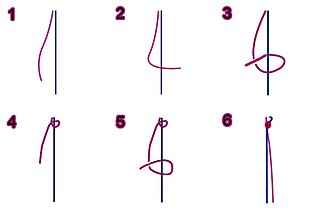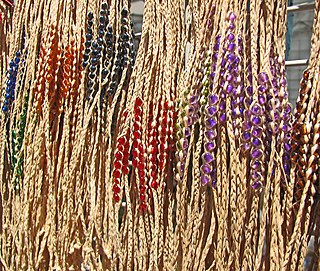
Jewellery consists of decorative items worn for personal adornment, such as brooches, rings, necklaces, earrings, pendants, bracelets, and cufflinks. Jewellery may be attached to the body or the clothes. From a western perspective, the term is restricted to durable ornaments, excluding flowers for example. For many centuries metal such as gold often combined with gemstones, has been the normal material for jewellery, but other materials such as glass, shells and other plant materials may be used.

A wire is a flexible, round, bar of metal.

Nelvana Limited is a Canadian animation studio and entertainment company owned by Corus Entertainment. Founded in July 1971 by Michael Hirsh, Patrick Loubert, and Clive A. Smith, it was named after Nelvana of the Northern Lights, the first Canadian national superhero, who was created by Adrian Dingle. The company's production logo is a polar bear looking at Polaris, the North Star.

Macramé is a form of textile produced using knotting techniques.

The fashion of the 2000's is often described as a global mash up, where trends saw the fusion of vintage styles, global and ethnic clothing, as well as the fashions of numerous music-based subcultures. Hip-hop fashion generally was the most popular among young people of all sexes, followed by the retro inspired indie look later in the decade.

A friendship bracelet is a decorative bracelet given by one person to another as a symbol of friendship. Friendship bracelets are often handmade, usually of embroidery floss or thread and are a type of macramé. There are various styles and patterns, but most are based on the same simple half-hitch knot. They represent a friendship that is strong and everlasting.

Hairwork, or jewelry or artwork made of human hair, has appeared throughout the history of craft work, particularly to be used for private worship or mourning. From the Middle Ages through the early twentieth century, memorial hair jewelry remained common. Hair, considered to be a remnant off the person it was cut from, also has often played a part in myths and legends; in a Swedish book of proverbs, one can read that “rings and bracelets of hair increase love”. One example can be found in Denmark, at Rosensborg’s palace, which is a bracelet of precious metal with a simple braided lock of hair - a gift from King Christian IV (1577-1648) to his queen. Another example would be the rings commemorating the execution of King Charles I of England (1600-1649), which circulated among his faithful supporters. Other famous people who owned hair jewelry include Napoleon, Admiral Nelson, Queen Victoria and her large family, Christina Nilsson and Jenny Lind.

Maria Snyder is an artist, designer, model, activist and entrepreneur. Snyder's artistic background began in her youth as a painter and sculptor. She is the daughter of industrialist real estate developer, Arthur T. Snyder, who was an early pioneer in the revitalization of Portland, Maine. Snyder attended school in Athens, Greece, studied at the American University in Paris and received a master's degree in 20th Century Art History.

Hemp jewelry uses hemp twine material which is made from the Cannabis sativa plant, otherwise known as “Common Hemp”, which is cultivated to make goods such as food, fuel, clothing and textiles, cosmetics, paints, paper, building materials, and plastics, among others. Some types of hemp jewelry include bracelets, necklaces, anklets, rings, watches, masks, purses, and other adornments. The jewelry can also make use of other materials, such as glass, wood, bones, rocks, or gems.

Native American jewelry refers to items of personal adornment, whether for personal use, sale or as art; examples of which include necklaces, earrings, bracelets, rings and pins, as well as ketohs, wampum, and labrets, made by one of the Indigenous peoples of the United States. Native American jewelry normally reflects the cultural diversity and history of its makers, but tribal groups have often borrowed and copied designs and methods from other, neighboring tribes or nations with which they had trade, and this practice continues today. Native American tribes continue to develop distinct aesthetics rooted in their personal artistic visions and cultural traditions. Artists may create jewelry for adornment, ceremonies, and display, or for sale or trade. Lois Sherr Dubin writes, "[i]n the absence of written languages, adornment became an important element of Indian communication, conveying many levels of information." Later, jewelry and personal adornment "...signaled resistance to assimilation. It remains a major statement of tribal and individual identity."

A row counter for hand knitting is a tally counter for counting rows or courses worked, for counting stitch pattern repetitions, or for counting increases or decreases of the number of stitches in consecutive rows. The first commercially produced one appeared on the market in the 1920s after the general public started regularly knitting from unfamiliar printed and complex patterns. Design variations include on-needle barrel-shaped counters for straight-needle work, stitch-marker counters for knitting on double-pointed and circular needles, complex counters which attempted to assist with decreases, increases and lacework, stand-alone hand-held counters in imitation of the hand-tally, pendant counters worn round the neck and online software for iPhones.

The 2010s were defined by hipster fashion, athleisure, a revival of austerity-era period pieces and alternative fashions, swag-inspired outfits, 1980s-style neon streetwear, and unisex 1990s-style elements influenced by grunge and skater fashions. The later years of the decade witnessed the growing importance in the western world of social media influencers paid to promote fast fashion brands on Pinterest and Instagram.

Ancient Egyptian clothes refers to clothing worn in ancient Egypt from the end of the Neolithic period to the collapse of the Ptolemaic Kingdom with the death of Cleopatra in 30 BC. Egyptian clothing was filled with a variety of colors. Adorned with precious gems and jewels, the fashions of the ancient Egyptians were made for not only beauty but also comfort. Egyptian fashion was created to keep cool while in the hot desert.

Lego Friends are a product range of Lego construction toys designed primarily for girls that was launched in 2012. It introduced "mini-doll" figures, which are about the same size as traditional Lego minifigures but are more detailed and realistic. The original cast consisted of Andrea, Olivia, Stephanie, Mia and Emma. The theme was rebooted and relaunched in January 2023 to focus on a more diverse cast of characters, the main cast now consisting of Aliya, Nova, Zac, Liann, Paisley, Leo, Autumn and Olly.
A kidult is an adult whose interests or media consumption is traditionally seen as more suitable for children. It can also mean a parent who acts childish with their children, but does not take on their duties as a disciplinarian.
Tiger tail wire is a thin wire encased in nylon often used in beaded jewellery, and particularly suited to stringing heavy beads and sharp beads, which tend to fray other kinds of thread. For this reason, tiger tail is the thread of choice for gemstones.

Ancient Roman jewelry was characterized by an interest in colored gemstones and glass, in contrast with their Greek predecessors who focused primarily on the production of high-quality metalwork by practiced artisans. Extensive control of Mediterranean territories provided an abundance of natural resources to utilize in jewelry making. Participation in trade allowed access to both semi-precious and precious stones that traveled down the Persian Silk Road from the East.
The salvation bracelet, also known as the gospel bracelet, witness bracelet, or wordless bracelet, is a bracelet used as a tool of Christian evangelism. The bracelet consists of a series of colored beads which represent key aspects of the Christian gospel.
Lego DOTS are a Lego theme based on multiple shapes and colourful tiles, with 1×1 elements intended to decorate the products. These include wearable wristbands and decorative room objects that can be individually customised. The theme includes over 30 mood tiles including facial expressions, a music note, a cosmic planet, star night and paw print. The theme was first introduced in March 2020. In January 2023, The Lego Group announced Lego DOTS will be discontinued in December 2023.















